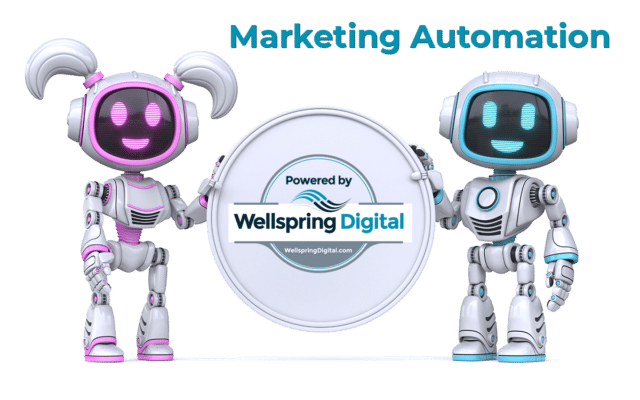
Marketing. It’s tricky. Marketing principles are hard to grasp, and the execution of great marketing shifts frequently. Customer behavior evolves, policies alter, algorithms change, and all the while, new platforms and tools keep cropping up.
Capitalizing on these changes and opportunities requires businesses to rely on marketing automation. It gives marketers access to real-time analytics, supercharges workflows, and makes keeping up with the marketing game much easier.
Facts About Marketing Automation
A recent study by invesp showed that:
- Marketing automation reduces marketing overhead by 12.2% while increasing sales productivity by 14.5%
- 80% of marketing automation users saw an increase in leads, and 77% experienced an increase in conversions
- Increasing leads, lead nurturing, and sales revenue were the top three reasons businesses employed marketing automation
But what is marketing automation?
What Is Marketing Automation?
Marketing automation is in part the sending of automated messages to certain people under certain conditions at a particular time. These messages can be standard email, social media posts and messages, and other digital channels.
Marketing automation aims to take a complex marketing campaign and make it easy and repeatable, with no need for constant human monitoring and management.
There are specific trends in marketing automation that are worth considering for your business. They are:
- Hyper-personalization
- AI and machine learning in SEO, content marketing, and email
- Omnichannel marketing
- Conversational chatbots
- Retargeting and retention with valuable content
- Voice search
- Mobile-first marketing automation
- Interdepartmental automation
Let’s look at each of these to learn how they can benefit a business.
Hyper-Personalization
Personalization used to be simple. “Hey [name]” was a game-changer for businesses at first, but now it’s not near enough. Real people expect real personalized experiences when they’re marketed to.
Hyper-personalization uses your database’s behavioral data rather than their name (or location, or company name) to hit prospects at different funnel levels with content that matters to them.
How does it work? You use data from real-time interactions your contacts have had with your website. You segment those users and set email triggers based on the pages they visit so that you can send relevant messages to customize a prospect’s experience with your brand.

AI and Machine Learning
AI (artificial intelligence) and machine learning have changed marketing automation in big, meaningful ways. You can write content faster with AI tools. You can also use AI to find better subject lines, generate content ideas, and more.
SEO AI tools help you find great high-ranking reference material, and they pull out keywords you need to add. They give you great metrics, like keyword difficulty, SERPs, and monthly search volume.
While the rise of the machines is inevitable, remember that you also need a human element to explore AI. They can’t think like us. At least not yet.
Omnichannel Marketing
This is the “creepy” sort of marketing people talk about. You see an ad on Instagram. You click on it. Later on, you see ads for the same brand or same product EVERYWHERE.
This is an example of omnichannel marketing. Brands retarget users and appear all over the internet. Marketing automation propels content throughout the customer journey, delivering messages to prospects wherever they are.
Conversational Chatbots
Chatbots allow brands to have conversations with prospects without needing an actual human to control the conversation. While we don’t recommend this type of marketing in all situations, since the human touch is very important, chatbots can be a powerful tool in your marketing automation toolbox.
Great for starting a conversation, answering FAQs, and more, chatbots have a place in every industry. You can keep them running after hours, and you can use them until human intervention is needed, like when a question gets complicated or when someone asks to speak to a person.
Retargeting and Retention
It’s all about the cookie. Cookies are tiny pieces of data that let websites learn more about your online behavior. But, in Apple’s iOS 14 update, users can now block cookies.
This prioritization of user privacy has created a cookie drought, and marketers have to find new ways to get eyes on their websites. Google Ads has data-driven attribution that uses machine learning to see how different marketing activities have contributed to a conversation.
Learning how to use that will be critical in the coming years. It’s all about creating great content and then paying attention to the data you get about how users interact with that content.
Voice Search
As technology advances and more and more shopping and consuming humans avoid the keyboard, voice-command optimized content is going to be necessary for every competing brand.

Voice search provides convenience and generates amazing results for users when looking for content online. This makes voice search an important priority. It is smart to optimize marketing content to accommodate voice command now for better conversion later.
Mobile-First Automation
Look on a subway platform or a gate at the airport. The people there are all doing the same thing – looking at their phones. Not only do websites and emails need to be optimized for mobile, but other mobile-first strategies should also be used for greater reach.
SMS, push notifications, and in-app ads are great tools. And, many users (especially young people) allow their service providers to use their mobile data to provide a more personalized experience. Take advantage of that.
Inter-Departmental Automation
None of these marketing automation strategies work if the marketing efforts don’t convert. Inter-departmental alignment is necessary to standardize how MQLs and SQLs turn into actual customers.
Marketing automation can help bridge the gap between sales and marketing departments. First, start with a properly set-up CRM, then sort out your lead scoring. Retarget potential customers to turn them into warmer leads, and ensure there are easy ways for departments to communicate to result in more conversions.
There are many exciting things on the marketing automation horizon! Keep an eye on our blog for more tips and strategies.